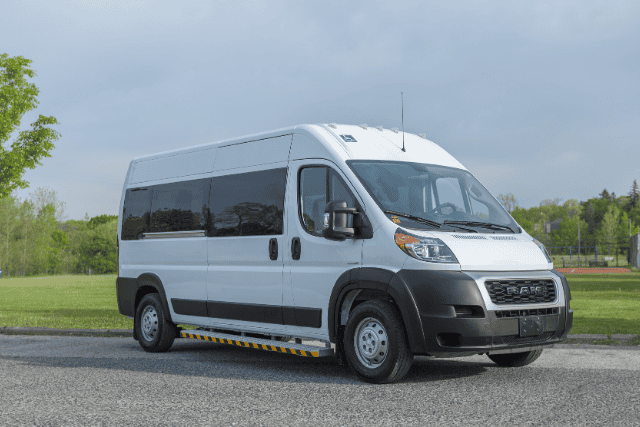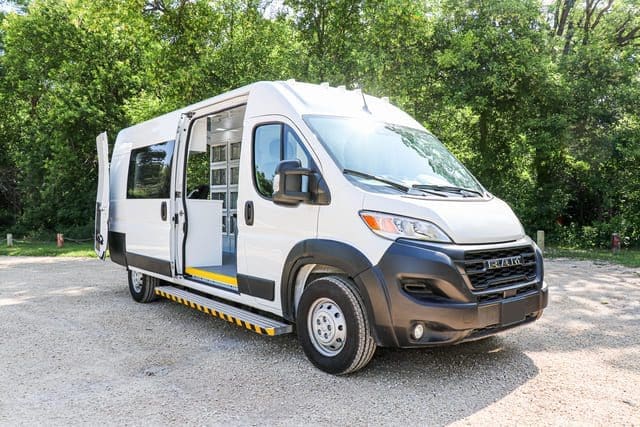Has your organization ever been in a situation where the wheelchair lift stopped working at the worst possible time? Maybe you’ve got a tight schedule, clients waiting, and suddenly, the wheelchair lift won’t budge. If this sounds familiar, you’re not alone.
Organizations like yours rely on wheelchair vans to get people where they need to go. When your van’s wheelchair lift has issues, it can mean missed appointments, delays in service, and a lot of frustration.
Not addressing your wheelchair lift problems can hurt your operations. More downtime means lost revenue, unhappy clients, and even safety risks. We know how stressful this can be, and this article will help you troubleshoot your problems and find solutions.
At AVAN Mobility, we build accessible vehicles that remove barriers to healthcare and transportation. Take a look at the Community Clinic of Southwest Missouri which is using the Mobile Clinic Van to provide mobile healthcare for the uninsured in Missouri. While we’re proud of the work we do, we know we’re not the only option out there, and our goal is to help you make informed decisions that work for your organization.
In this article, we’ll break down the five most common problems with wheelchair lifts for vans and give you practical solutions to troubleshoot the problems.
5 common problems with wheelchair lifts
You will use wheelchair lifts many times a day in your wheelchair van. Because of that, they need more maintenance than some of the other parts of your van. Let’s dive into some of the wheelchair lift problems you might encounter.
1. Electrical failure with your wheelchair lift
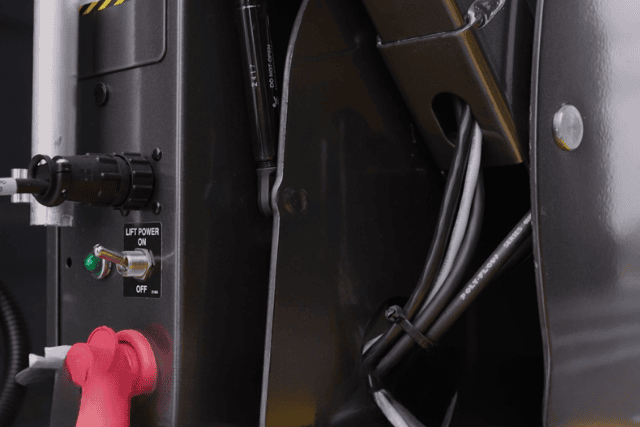
While rare, electrical failures can happen from time to time with wheelchair lifts. Even though they’re usually reliable, things can still go wrong. The design of every part of the lift prioritizes safety, but sometimes, an electrical issue can cause the lift to stop working.
What could happen: A fuse may blow, which shuts down the lift.
Why it happens: Electrical components can wear out over time, just like in any other vehicle.
Solution: Contact your customer care team
If you suspect that your lift has stopped working due to an electrical issue, contact the company you purchased your van from to get a proper diagnosis and schedule a repair. Since electrical problems with wheelchair lifts usually exceed most people’s skill set, it’s safer to have a professional handle them.
Got any questions about wheelchair lift problems yet? Click the button to the right of this article.
2. Safety features prevent your lift from working
Sometimes, the safety features on your wheelchair lift might stop it from functioning normally. These features exist to protect both your clients and operators.. For example, the rollboard barrier helps keep the person in the wheelchair secure during operation. However, if someone triggers these safety features incorrectly, they can cause the lift to stop working as it should.
What could happen: The lift might not activate when a client sits in it, ready to be transported to their destination.
Why it happens: Safety features can be accidentally engaged, which prevents the lift from moving.
Solution: Check the safety catch hooks
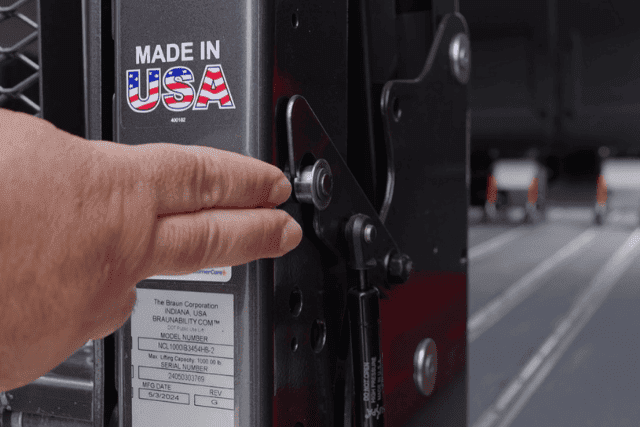
If your wheelchair lift for a van isn’t folding up properly, here’s what you can check:
Check the power: If you notice your wheelchair lift isn’t unfolding, make sure the lift’s power switch is turned on. The switch is located at the bottom of the pump module, as you can see in the below diagram.
Inspect the safety catch hooks: Safety catch hooks are built to stop the lift from deploying if the hydraulics fail. However, they should not be used to stow the lift during transport. These hooks are on both sides of the lift. Make sure they aren’t engaged by accident.
Use the manual backup: If the lift isn’t responding, use the manual backup pump to fully stow the lift. This can reset the safety features and get the lift working again.
If you run into any problems troubleshooting this issue, call the customer care team from your wheelchair van provider to help resolve the problem.
3. Control lights won’t turn on, and the unfold button isn’t working
If your van wheelchair lift isn’t responding and the control lights aren’t lighting up, this could be a power problem. Many van operators in the U.S. often face this situation, especially when community services or non-profits frequently use their vehicles for accessible transport.
What could happen: You might press the unfold button, but nothing happens, and the control lights stay off. This can cause delays for your team and leave your clients waiting.
Why it happens: The lift may not be getting power. It could be a simple switch issue or a minor electrical fault.
Solution: Check your wheelchair lift power switch
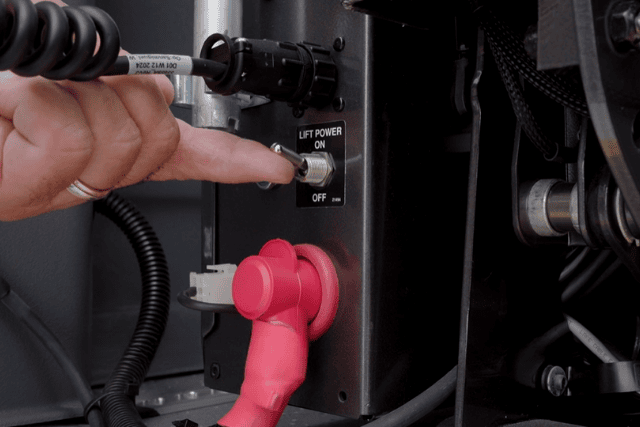
Follow these steps to troubleshoot the issue:
Inspect the power source: Look for the lift’s power switch, which is found near the pump module. Make sure it’s turned on. If it’s working properly, you’ll see a green light indicating the lift has power.
Manual reset: If the power is on and still isn’t working, try using the manual backup pump. This helps reset any safety switches that might be preventing the lift from unfolding.
When to call for support: If there’s still no sign of life after these checks, the issue might be electrical. Contact the company that sold you the van wheelchair lift and schedule a service appointment to get things checked out.
4. Wheelchair lift gets stuck
Imagine one day you’re attempting to raise or lower the wheelchair lift for a client in your van, and suddenly, it stops moving. This can be embarrassing and lead to a poor reputation. This issue often happens because something is pressing against the lift’s safety barriers.
What could happen: If you can’t raise or lower the wheelchair lift, your client might get stuck in it.
Why it happens:
- Inboard and outboard barriers: These are safety features designed to stop the lift if something is blocking it or if it’s unsafe to move. If these barriers sense pressure, they halt the lift to prevent accidents.
- Common culprits: Items like wheelchairs, luggage, or even loose equipment can lean on these barriers, causing them to activate and stop the lift’s movement.
Solution: Check for pressure on the barriers
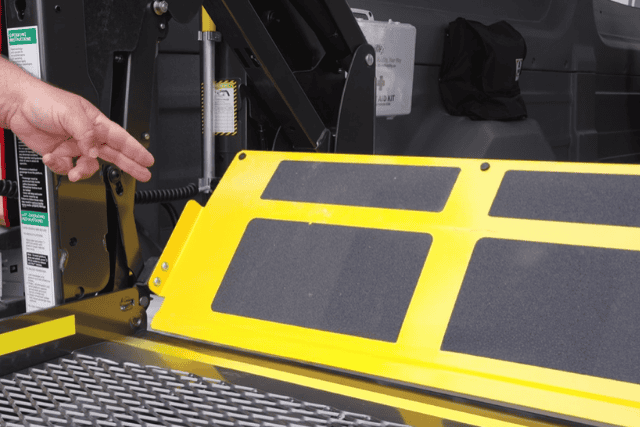
To get your wheelchair lift back in action, look for any objects and make sure no one is unknowingly pressing against the inboard or outboard barriers. This also includes checking for stray equipment or loose items inside the van.
5. Wheelchair lift is folding up too slowly
Have you ever experienced a situation where your wheelchair lift struggles to fold up or operates too slowly? It can be frustrating when the lift doesn’t work smoothly, and this issue often involves the fold and unfold buttons on the hand-held pendant.
What could happen: Clients may become frustrated or anxious if they have to wait longer than expected, especially if they rely on timely transportation for medical appointments or other important engagements. It could also create safety hazards that can lead to injury.
Why it happens: Objects pressing against the inboard or outboard barriers can prevent the lift from folding correctly.
Solution: Check for barriers and adjust the safety valve
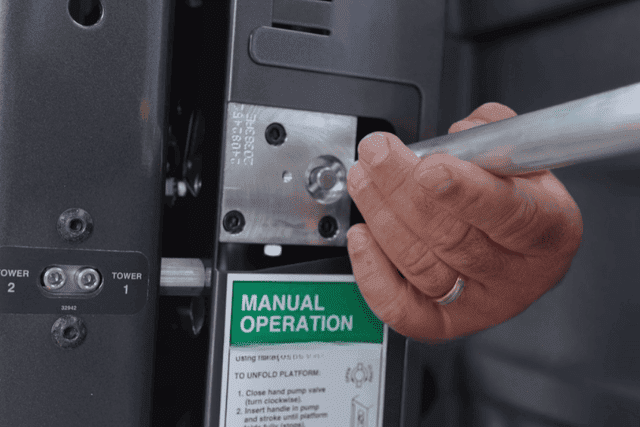
To solve this problem, here’s what you need to do:
Clear the barriers: This is similar to the troubleshooting solution for the fourth problem we discussed earlier. Make sure that nothing is blocking or pressing against the inboard or outboard barriers. Clear away items like the wheels of wheelchairs, bags, purses, or other objects.
Adjust the safety valve: If the barriers are clear but the lift is still slow or needs help folding, you might need to adjust the safety valve. This can be a bit technical, so it’s best to contact your Customer Care Team if you’re unsure how to do this.
Solving your wheelchair lift problems: What’s next?
You came to this article because you’re likely dealing with stressful issues with your wheelchair lift and need solutions fast. After reading this guide, you’ve learned about some of the most common problems with wheelchair lifts for vans and how to address them, from electrical failures to folding issues.
At AVAN Mobility, we understand how important it is for your wheelchair lift to work reliably, especially when so many people depend on it daily. Over the past decade, our focus has always been on manufacturing safe, accessible, and dependable vehicles to help break down barriers to mobility and healthcare.
We aim to support you, whether you face issues or seek to make your next investment in accessible transportation. If you have any questions about wheelchair lifts or are thinking about buying a new wheelchair van because you’re tired of your current one, click the button below to speak with a mobility expert.t.
Not ready to talk to someone yet? That’s alright. Check out our article on the cost of a wheelchair van. If you’d prefer to watch a video to learn about that instead, see below!


